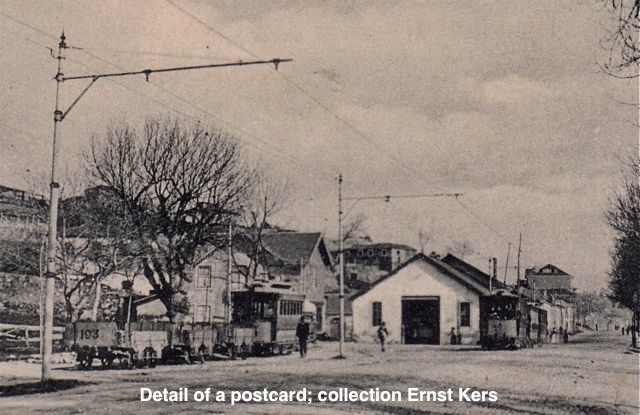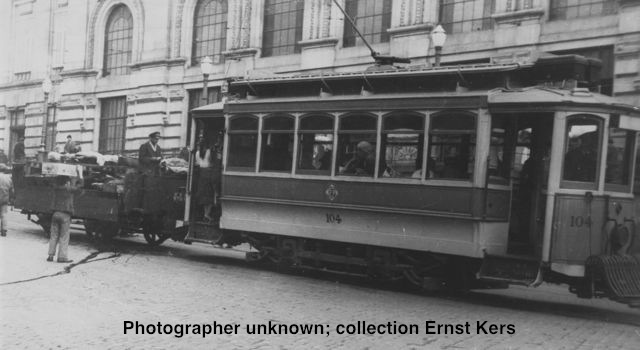Freight and works trailers
Of the four major groups of trams, electric passenger cars, mule cars / trailers for passengers, electric freight cars and mule cars / trailers for freight, the history of the last is the most obscure. Both mule tram operators had freight cars, but of the CCAPFM it is only known there were six freight cars when this company merged with the CCFP in 1892.In 1874 the CCFP acquired from Starbuck six mixed cars for the transport of passengers and luggage, of which two were small, and four freight cars with 4 t capacity of which two were open and two closed. It is not clear if the “mixed” cars had accommodation for passengers or were just meant for the transport of luggage in combination with passenger trams. In 1876 the CCFP specified there were six luggage cars and four freight cars. In later years new cars were constructed and probably also existing cars reconstructed from one type in another. By 1882 the total number of cars was twelve of which three were used for luggage and nine for freight. By 1892 the CCFP had about 18 cars for freight and luggage.
In 1899 A Constructora delivered 13 open freight cars, 6 with high and 7 with low boards. The same company delivered six more cars in 1901, probably raising the fleet to its largest extend of 41 vehicles. By 1905 there were 38 freight trailers, one of them was scrapped in 1907. By 1919 there were probably still 36 freight and works trailers:
- 60 - one zorra 4 t
- 61-62 - two wagons 4.5 t
- 63 - one zorra via e obras (permanent way)
- 64-65 - two carros socorros via e obras (break-down cars permanent way)
- 66-79 - fourteen zorras 5.5 t
- 80-82, 84-85, 88-96 - fourteen zorras 4 t
- 97 - one zorra via e obras (permanent way)
- 98 - one tangue irrigação (maybe a sprinkler car)

The Ouro depot around 1902 with at the left
three freight trailers behind an electric tram.

This photo made in 1943 in front of the
São Bento station shows a 6-window Constructora
tram with a freight trailer. Likely the trailer was used
for transporting fish and the tram used by the ladies
selling the fish.
No historical data are know of the small lorries, in Porto nicknamed Joaninhas. These tiny vehicles were until the 1990’s used by the permanent way department. It happened frequent two were used to carry pieces of rail. These combinations were sometimes pulled, but often pushed by a zorra. In these cases on the first Joaninha was an employee of the STCP seated continuously beating with a hammer on a large bell to warn the other traffic. Joaninhas were also used to carry a welding power supply for track repair. In 2002 one was used, fitted with scaffolding, to mount the overhead wires above the new tracks at Cordoaria. One of the most remarkable jobs was when one was hauled by a museum trolley-bus participating the 1997 tram parade. The trolley-bus did ride on its own power with one trolley-pole at the overhead of the tram and the other connected by a cable with the Joaninha.